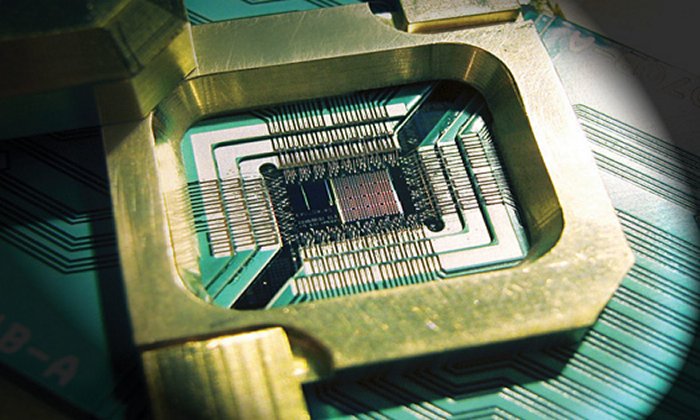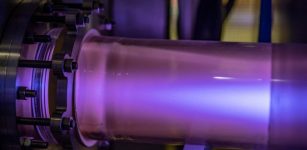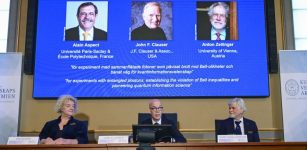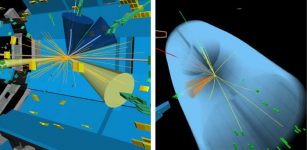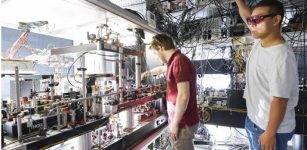A Path Toward Quantum Computing In Real-World Conditions – Is Now Opened
Eddie Gonzales Jr. – MessageToEagle.com – The quantum computing market is projected to reach $65 billion by 2030, a hot topic for investors and scientists alike because of its potential to solve incomprehensibly complex problems.
Drug discovery is one example. To understand drug interactions, a pharmaceutical company might want to simulate the interaction of two molecules.
Image credit: alberto – CC BY-SA 4.0
The challenge is that each molecule is composed of a few hundred atoms, and scientists must model all the ways in which these atoms might array themselves when their respective molecules are introduced. The number of possible configurations is infinite — more than the number of atoms in the entire universe. Only a quantum computer can represent, much less solve, such an expansive, dynamic data problem.
Mainstream use of quantum computing remains decades away, while research teams in universities and private industry across the globe work on different dimensions of the technology.
A research team led by Xu Yi, assistant professor of electrical and computer engineering at the University of Virginia School of Engineering and Applied Science, has carved a niche in the physics and applications of photonic devices, which detect and shape light for a wide range of uses including communications and computing. His research group has created a scalable quantum computing platform, which drastically reduces the number of devices needed to achieve quantum speed, on a photonic chip the size of a penny.
Olivier Pfister, professor of quantum optics and quantum information at UVA, and Hansuek Lee, assistant professor at the Korean Advanced Institute of Science and Technology, contributed to this success.
Nature Communications recently published the team’s experimental results, A Squeezed Quantum Microcomb on a Chip. Two of Yi’s group members, Zijiao Yang, a Ph.D. student in physics, and Mandana Jahanbozorgi, a Ph.D. student of electrical and computer engineering, are the paper’s co-first authors. A grant from the National Science Foundation’s Engineering Quantum Integrated Platforms for Quantum Communication program supports this research.
Quantum computing promises an entirely new way of processing information. Your desktop or laptop computer processes information in long strings of bits. A bit can hold only one of two values: zero or one. Quantum computers process information in parallel, which means they don’t have to wait for one sequence of information to be processed before they can compute more. Their unit of information is called a qubit, a hybrid that can be one and zero at the same time. A quantum mode, or qumode, spans the full spectrum of variables between one and zero — the values to the right of the decimal point.
Researchers are working on different approaches to efficiently produce the enormous number of qumodes needed to achieve quantum speeds.
Yi’s photonics-based approach is attractive because a field of light is also full spectrum; each light wave in the spectrum has the potential to become a quantum unit. Yi hypothesized that by entangling fields of light, the light would achieve a quantum state.
You are likely familiar with the optical fibers that deliver information through the internet. Within each optical fiber, lasers of many different colors are used in parallel, a phenomenon called multiplexing. Yi carried the multiplexing concept into the quantum realm.
Micro is key to his team’s success. UVA is a pioneer and a leader in the use of optical multiplexing to create a scalable quantum computing platform. In 2014, Pfister’s group succeeded in generating more than 3,000 quantum modes in a bulk optical system. However, using this many quantum modes requires a large footprint to contain the thousands of mirrors, lenses and other components that would be needed to run an algorithm and perform other operations.
“The future of the field is integrated quantum optics,” Pfister said. “Only by transferring quantum optics experiments from protected optics labs to field-compatible photonic chips will bona fide quantum technology be able to see the light of day. We are extremely fortunate to have been able to attract to UVA a world expert in quantum photonics such as Xu Yi, and I’m very excited by the perspectives these new results open to us.”
Yi’s group created a quantum source in an optical microresonator a ring-shaped, millimeter-sized structure that envelopes the photons and generates a microcobe, a device that efficiently converts photons from single to multiple wavelengths. Light circulates around the ring to build up optical power. This power buildup enhances chances for photons to interact, which produces quantum entanglement between fields of light in the microcomb.
Through multiplexing, Yi’s team verified the generation of 40 qumodes from a single microresonator on a chip, proving that multiplexing of quantum modes can work in integrated photonic platforms. This is just the number they are able to measure.
“We estimate that when we optimize the system, we can generate thousands of qumodes from a single device,” Yi said.
Yi’s multiplexing technique opens a path toward quantum computing for real-world conditions, where errors are inevitable. This is true even in classical computers. But quantum states are much more fragile than classical states.
The number of qubits needed to compensate for errors could exceed one million, with a proportionate increase in the number of devices. Multiplexing reduces the number of devices needed by two or three orders of magnitude.
Yi’s photonics-based system offers two additional advantages in the quantum computing quest. Quantum computing platforms that use superconducting electronic circuits require cooling to cryogenic temperatures. Because the photon has no mass, quantum computers with photonic integrated chips can run or sleep at room temperature. Additionally, Lee fabricated the microresonator on a silicon chip using standard lithography techniques. This is important because it implies the resonator or quantum source can be mass-produced.
“We are proud to push the frontiers of engineering in quantum computing and accelerate the transition from bulk optics to integrated photonics,” Yi said. “We will continue to explore ways to integrate devices and circuits in a photonics-based quantum computing platform and optimize its performance.”
Written by Eddie Gonzales Jr. MessageToEagle.com Staff

